Manderallen
ACCESS: Restricted
- Joined
- 28 October 2019
- Messages
- 6
- Reaction score
- 4
Good afternoon,
For some time, I have been interested in information on the Pratt & Whitney J57-P-420. I have every book on the F-8 Crusader I can find. That has provided some information but there is many holes in the story. In Naval Fighters #16 there are engine ratings that refer to Military ratings of 12,400 lbs st and Afterburning ratings of 19,600 lbs st on page 104. All references are in relation to late F-8H and F-8J models. Wikipedia lists many variants but nothing that lists more in relation to this late Navy variant.
Does anyone here have any other details on this model of the J57? Also, any information on what changes allowed the increase in thrust from the J57-P-20a? Lastly is there any usage of the 420 in the French Navy's Crusaders?
Thank you in advance. Hope you all are having a great weekend.
Brad
(If I need to place my thread in a different area, please advise.)
For some time, I have been interested in information on the Pratt & Whitney J57-P-420. I have every book on the F-8 Crusader I can find. That has provided some information but there is many holes in the story. In Naval Fighters #16 there are engine ratings that refer to Military ratings of 12,400 lbs st and Afterburning ratings of 19,600 lbs st on page 104. All references are in relation to late F-8H and F-8J models. Wikipedia lists many variants but nothing that lists more in relation to this late Navy variant.
Does anyone here have any other details on this model of the J57? Also, any information on what changes allowed the increase in thrust from the J57-P-20a? Lastly is there any usage of the 420 in the French Navy's Crusaders?
Thank you in advance. Hope you all are having a great weekend.
Brad
(If I need to place my thread in a different area, please advise.)

